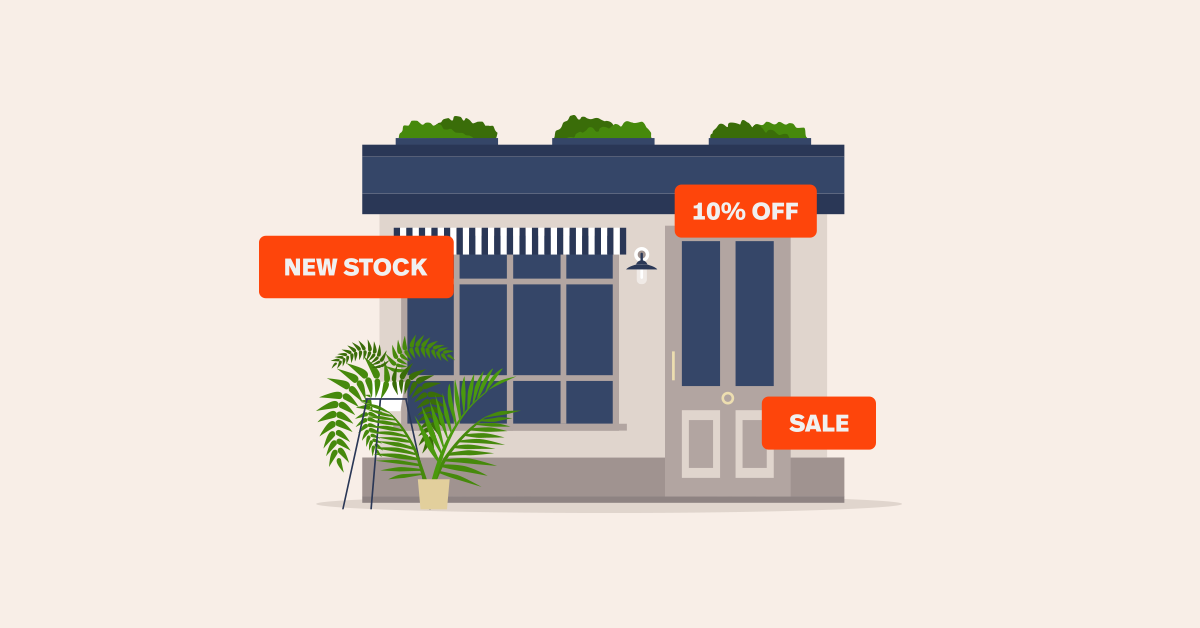
Retail marketing helps your business expand its reach, connect with customers, nurture relationships and tell your brand story. It can also be used to differentiate yourself from your competition.
Problem is, setting the right budget ratios for retail advertising can be tricky. Should you think outside the box and blow your budget on a series of in-store events? Will social media be more effective if you spend money on video creation or ads? Which social media should you focus on? Gone are the days of choosing between TV, radio and print ads—retailers have more advertising channels than ever, and there is no one size fits all strategy.
In this article, we’ll go through 12 advertising and retail marketing ideas and discuss how to choose which will be best for you:
- What is retail marketing?
- 9 retail advertising ideas to catch the eyes of potential customers
- Leverage social media
- Beef up your email marketing
- Consider influencer marketing
- Use your in-store assets
- Consider SMS marketing
- Leverage video
- Try out direct mail
- Online listings
- Podcast advertising
- 9 marketing and promotion ideas for retail stores
- Start a referral campaign
- Run a win-back marketing campaign
- Promote your loyalty program
- Run in-store events
- Offer free wifi
- Word of mouth
- Google shopping campaigns
- Ad image best practices
- Include product ratings
Profit and Loss Template
Examine the financial health of your business by highlighting exactly how much revenue is being generated versus what’s being spent.
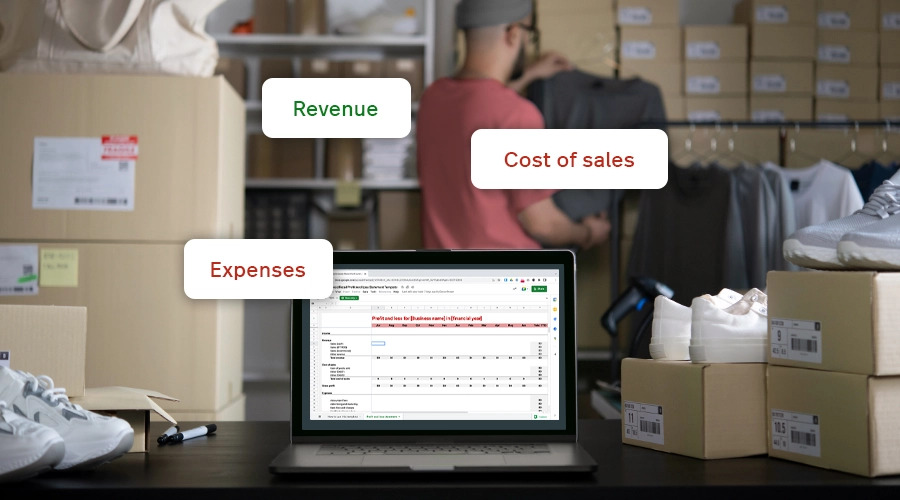
What is considered retail marketing?
Today, retail marketing, also known as retail advertising, can mean organic content (like blog posts), paid content (like advertisements) or a mix of both. This includes both in-person and digital strategies, which can encompass everything from running giveaways on social media to having a sign outside your brick-and-mortar store detailing a special promotion.
In many cases, businesses benefit from using a combination of retail marketing strategies at once (which is sometimes referred to as a “marketing mix”) to reach more people.
However, knowing exactly which portions of your budget to allocate to each part of the mix isn’t cut and dry. Some companies will get by with an entirely social media based strategy, while others thrive with direct mail and referral campaigns. The trick is to know what retail marketing strategies work for your customer base, which means testing and recording results to fine tune your approach.
The 4 Ps
Retail marketing has 4 key components, also known as the “4 Ps”: Product, Price, Place, and Promotion.
- Product. First is the Product, which is the physical item that’s being sold.
- Price. The second is Price, which refers to the pricing strategy that the merchant uses to sell the item. (Examples include “everyday low prices,” implementing pricing psychology like using “$9.99” etc.)
- Place. Third is “Place” which refers to the location or platform used to sell products.
- Promotion. Finally, there’s Promotion, which is what the retailer does to get the word out and entice sales.
Successfully executing your retail marketing strategies requires a solid handle on the 4 Ps. Tracking these components and ensuring that they’re all working together is essential to any marketing initiative.
For best results, use a POS and retail management system that allows you to manage the 4 Ps with ease. With the right platform, you can keep all your ducks in a row (i.e., your products, prices, places, and promotions) and focus on bringing your retail marketing ideas to life.
When you’re considering which advertising strategy to use for your business, it’s a good idea to look at a number of different options to see what would work best.
9 retail advertising ideas to catch the eyes of potential customers
Here are some ideas that can help you bring new customers in store (or to your ecommerce site).
1. Leverage social media
When it comes to retail and social media, there are four platforms you should seriously consider: Facebook, Instagram, Pinterest and TikTok. These are the most consumer-centric networks, making them ideal for merchants looking to reach new customers.
- TikTok
Marketing on Facebook
Even with the rise of newer platforms like TikTok, Facebook is still the most popular social media platform in the world. Facebook is ideal for sharing frequent updates with customers, promoting products, creating on-platform events and features like live broadcasting to make meaningful connections.
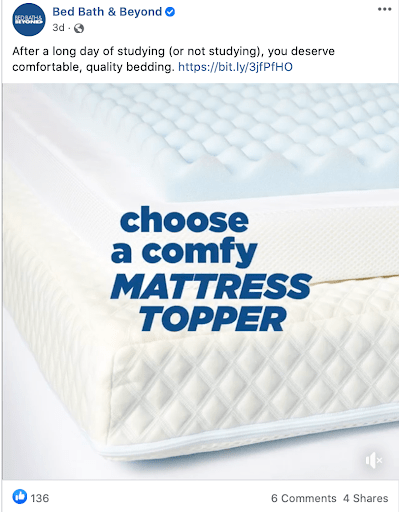
You can also provide direct links to your website in your posts, or connect your Facebook page to a shoppable catalog.
Start a Facebook Group
Think of Facebook Groups as clubs or communities where your most engaged customers and fans can congregate.
One example of a company that’s leveraging Facebook Groups is Peloton, an indoor cycling brand. The company established the Official Peloton Rider Page, which is “intended to be a community board for Peloton members to share their experiences on the Peloton bike and iOS app.”
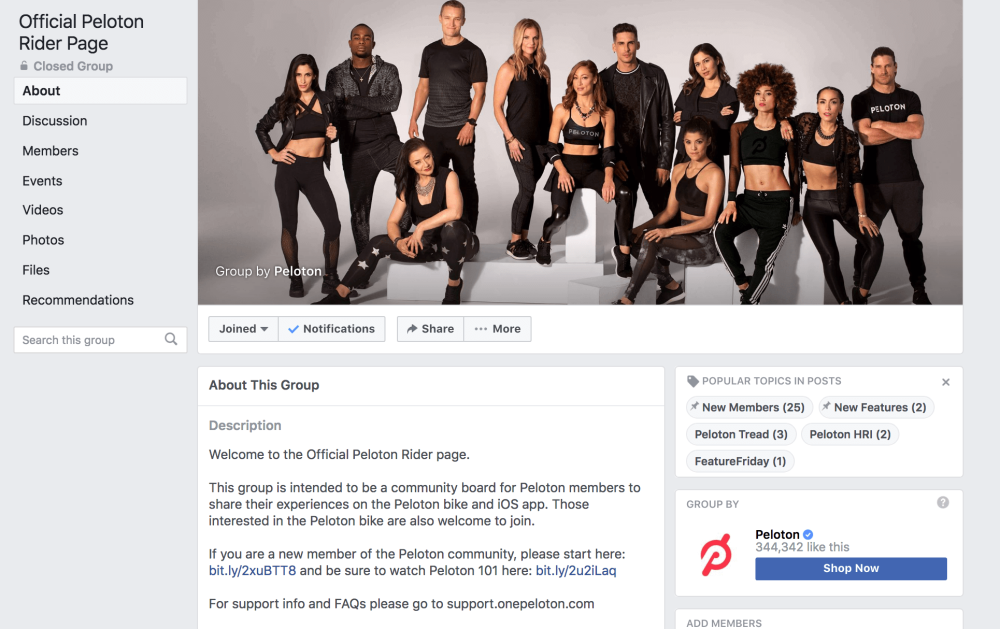
The Group is very active, and people use it to share their workouts, ask questions, dish out tips, and more.
See if you can do something similar for your Facebook presence. If you sell something that’s centered around a particular lifestyle or interests (e.g. fitness, food, crafts), then consider creating a Facebook Group for your patrons and potential customers.
Run Facebook ads
Your team should be taking advantage of Facebook’s A/B testing features for ads, then keeping track of metrics (e.g. clicks, engagement, sales, etc) to optimise future campaigns.
Take note of the numbers, then use those insights to determine your ROI. This will help you determine which ad types are right for you and how much to budget for Facebook advertising.
Marketing on Instagram
Instagram is one of the most popular social platforms today, with over a billion monthly active users. What started as a photo sharing app in the early 2010s has now become a full-blown photo, video and shopping destination for consumers and businesses alike.
Your business can connect with your community by sharing short form video clips to Instagram Stories or Reels, posting product or in-store photos to the feed, hosting Live events through Instagram Lives or more long form through IGTV. Creating an Instagram Shop will let customers view and buy products directly from the app.
Carefully curate your visual content
Your Instagram posts should be anything but random. Your business needs to create a clear brand aesthetic so when people visit your profile, they get a quick idea of who your brand is.
Check out Clad and Cloth’s profile. You can see instantly from their collection of photos that their brand produces casual clothing items and likes a clean neutral palette with pops of color.
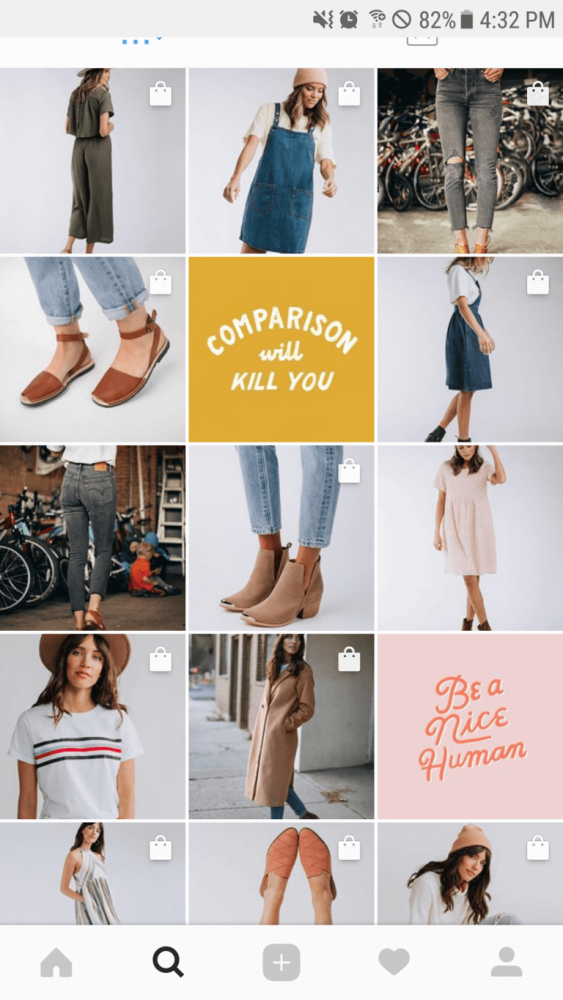
So, if you haven’t done so yet, spend time thinking about your brand aesthetic—does it need a refresh? Ask yourself what kind of first impression you want people to have about your brand. The answer will give your social media manager direction for your Instagram’s look and feel.
Use Instagram Stories
Instagram Stories allow you to be more informal with your aesthetic, as people expect Stories to be more spontaneous and less curated. You can use them to give people behind-the-scenes glimpses at your store or showcase new products.
A secondary feature of Instagram Stories is that you can create a few permanent ones to display on your profile, highlighting things you really want your potential customers to see.
Check out what Peridot Decorative Homeware is doing. The retailer uses these permanent Story spots to make it easy for people to view interior designs, shop for items, and more. They even created custom Story cover images to make them look more attractive.
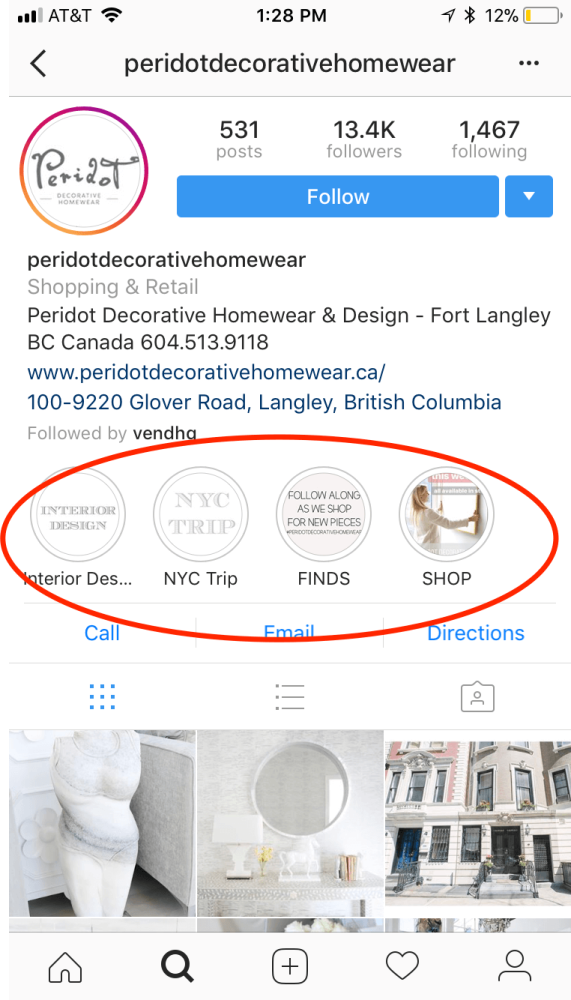
Stories can also do double duty as reels, always-on videos with a wider reach beyond just your followers. Instruct your marketing team to set a threshold of engagement—if a story passes it, it’s a candidate for being converted into a reel.
Marketing on Pinterest
If you have an eCommerce website, using Pinterest is a smart choice. Pinterest, like Google and YouTube, functions as a search engine. Over 450 million users flock to the platform to research buying decisions or find inspiration and how-to guides. If your business can be the answer they’re looking for, you’ll likely find success.
You can also work on creating content-focused pins with tutorials showing how to use a product. Here’s a great example from Sephora’s page:
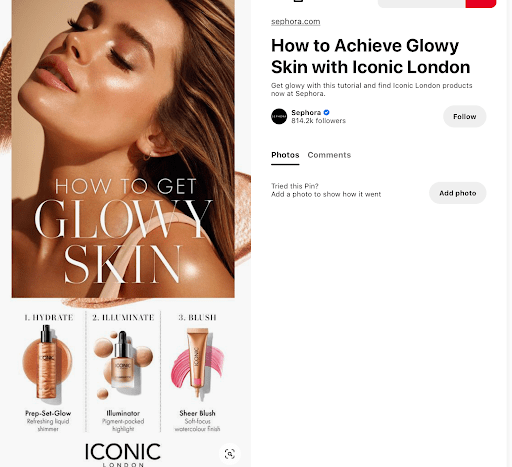
Pinterest also has shopping capabilities, so you can tag your products in certain pins for customers to shop directly from the platform. Advertising on Pinterest is another popular option. Promoted Pins can help you create targeted campaigns so that your ideal demographic will see your content.
Remember, curation is key
Like your Instagram profile, make sure that your team keeps your Pinterest boards carefully curated. Boards should be curated to make it simple for potential customers to navigate to things they’re interested in.
J.Crew, as you can see, has boards that make it easy for you to look at their jeans, their prints, or their stripes.
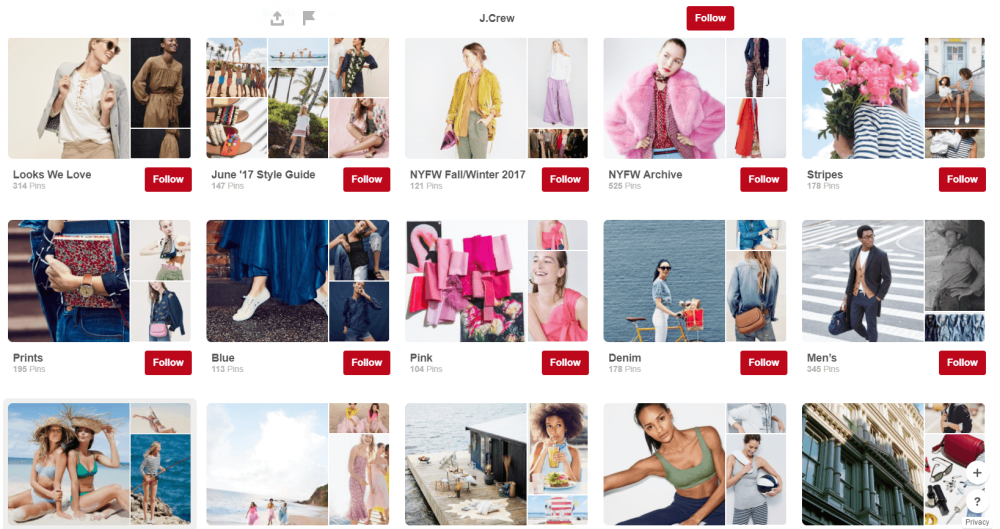
Be patient
The Pinterest algorithm doesn’t necessarily surface your content quickly. It can often take up to 6 months for your content to really start appearing in people’s feeds.
This means that, while your business should be pinning your products, pages that will do best for you organically are likely to be links to your blog posts.
You can allocate budget for blog posts specifically for Pinterest, such as gifting guides that help get your brand lift and will then direct your customers on to your correct pages all year round. As for products, they’ll do great on Pinterest in ad form.
Marketing on TikTok
TikTok is taking the social media world by storm. As one of the world’s fastest growing apps, TikTok became the first non-Facebook owned app to reach 3 billion installs globally.
The short form video format combined with TikTok’s interest-based algorithm makes the platform very small-business friendly. If you have someone on your team who is comfortable in front of the camera, all you need is a smartphone and our tips and tricks to get your business seen by thousands.
By connecting your ecommerce platform to TikTok through the TikTok Pixel, you can gather data about sales and customer actions on your site. You can use that data to create more effective ad campaigns and attract your target audience to your store.
2. Beef up your email marketing
Email marketing is still the most effective marketing channel, with a 4400% ROI. Taking advantage of email to acquire new customers just requires a little savvy-ness.
It will help you keep customers engaged without depending on an algorithm. With email marketing or loyalty software, you can send segmented campaigns based on your customers’ past purchases and current behaviours, like abandoned carts or views of a specific product page.
This form of targeted marketing is powerful and a great way to remind customers that you’re around.
Segment your non-customers
The best way to use email marketing for getting new customers is to segment your subscribers who haven’t purchased yet into their own list. (For even more effective and personalised emails, you should further segment this list by other relevant pieces of information.
You can then send people who haven’t purchased yet targeted campaigns with first-time buy offers or giveaways.
Showcase your story and values
Another great campaign idea is to send an email detailing your brand story. It’ll get people engaged with your brand and excited about your values.
The Farmer’s Dog is killing it on this front. Check out this gorgeous email sent to customers who haven’t yet purchased a product. Their story is touching and the 20% off coupon is a solid CTA to end on. (And fun fact: their marketing automation software also serves a personalized 20% off CTA to customers who read the email and then go to the website independently. Genius.)
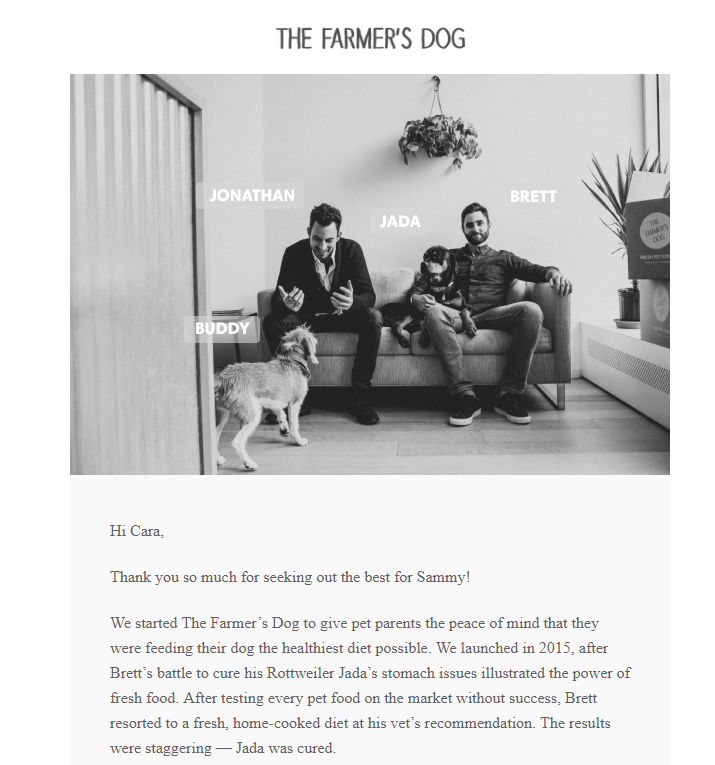
Provide value
Email promotions aren’t the only way to acquire new customers.
You also have to think about the long game of email + content marketing, in which you send valuable content without any hard sells or strings attached. This builds trust and positions your brand as an authority, so when people are ready to buy, they’ll think of you.
Check out what The Dollar Shave Club (DSC) is doing. While DSC sends promotional emails now and then, they also have DSC “Original Content” emails that contain informative (and entertaining) articles on grooming, health, style, work, and more.
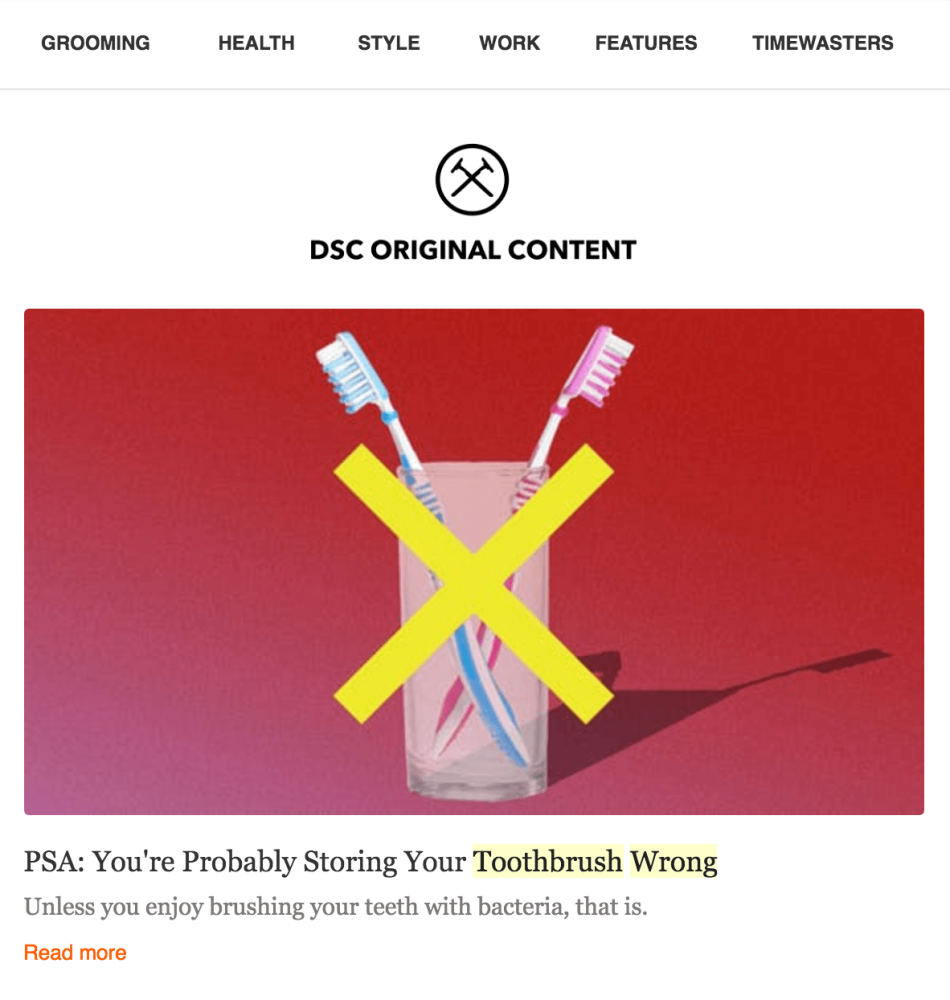
3. Consider influencer marketing
Influencer marketing, if done well, can help your business reach its marketing goals. With influencers, follower count isn’t everything. In fact, engagement rate is a better metric for determining whether or not an influencer is worth partnering with.
Influencers in the middle often have much higher engagement rates than their mega or micro follower counterparts—think 5000 to 500,000 as a budget sweet spot. A high engagement rate signifies a high amount of trust, and therefore, a higher likelihood of conversion for your business.
Find influencers that create content for the same target audience as your business and see if they are interested in partnering with your brand. You can do this by searching through your tagged photos, relevant hashtags or even your competitors’ accounts to create a shortlist of people to reach out to.
You can hire influencers to create photos or videos promoting the products in your store or specific event, like a grand opening.
How Morphe skyrocketed sales with influencer marketing
One brand, Morphe, used influencer marketing to become in less than a decade one of the most powerful names in the beauty industry. Morphe was founded in 2008 with the very intention of using beauty influencers, particularly those on Youtube, as their primary way to generate sales.
They have given many, many beauty influencers affiliate codes, but Morphe really refined the art of marketing by working very strategically with a certain few top influencers, whom they pay extra.
They also collaborated with these influencers to create customized beauty items, like eyeshadow palettes, which the influencers then encouraged their huge followings to purchase.
This strategy paid off in a big way when Morphe’s top influencer, Jaclyn Hill, delivered Morphe 1 million sales of her palette in 6 months last year. At $38/palette, that’s pretty life-changing for a brand.
4. Use your in-store assets
In-store retail marketing focuses exclusively on leveraging the customer’s in-store experience to promote brand and product awareness. Some of these strategies will also drive traffic into the store, too.
There are seven in-store retail marketing strategies you should think about using if you have a brick-and-mortar retail store.
- In-store merchandising
- Window displays
- Curb side displays
- Staff training
- Partnerships and collaborations
- In-store or virtual events
- Referral and loyalty programs
In-store merchandising
The best way to attract and convert customers is to wow them with your amazing merch. See to it that you’re always stocking the right products. Then once you have the right merchandise, come up with creative displays and arrangements to make them pop.
In-store visual merchandising includes everything from storefront displays and product displays to your cash wrap and retail POS system. The idea is to display your products in a way that draws attention to them and inspires customers to make a purchase.
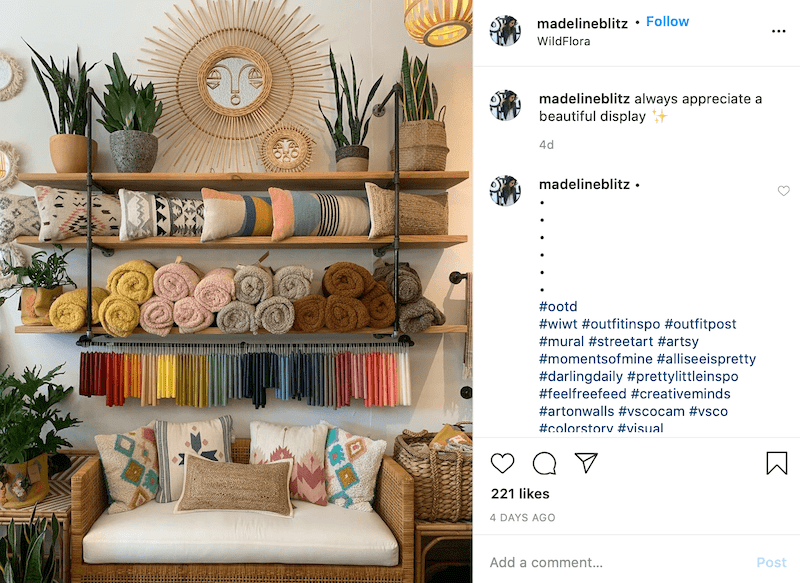
This can include any of the following:
- Signs promoting your special deals, like a buy-one-get-one offer
- Putting your fastest-selling items on a mannequin in the center of the store
- Point of purchase displays near your register encourage users to add on last-minute “impulse purchases”
- Identifying your “Lake Front Property.” The area of your store that generates the most revenue.
Window displays
Window displays are a great way to capture people’s attention as they’re walking or driving by your retail store, hopefully drawing them in. You can show off some of your best selling merchandise and represent your brand in an exciting, creative way.

When creating window displays, use lighting, colour and mood to your advantage.
Keep changing things up and try to update your displays at least once a month. For busy shopping seasons like the holidays, you want to do it every couple of weeks or even every week if possible.
Every retail store is different, so certain design tips may work better for others. The “best” design or look depends on your customers, so zero in on who you’re targeting and create a playbook for managers to craft displays specifically for them.
Also, consider telling stories with your displays. You can do this by selecting a theme, and finding stories in line with it.
Check out what Anthropologie is doing. The apparel retailer changes the window displays of its stores depending on certain seasons or events. What makes their window displays great, though, is that Anthropologie always finds a unique angle or story within its chosen season theme.
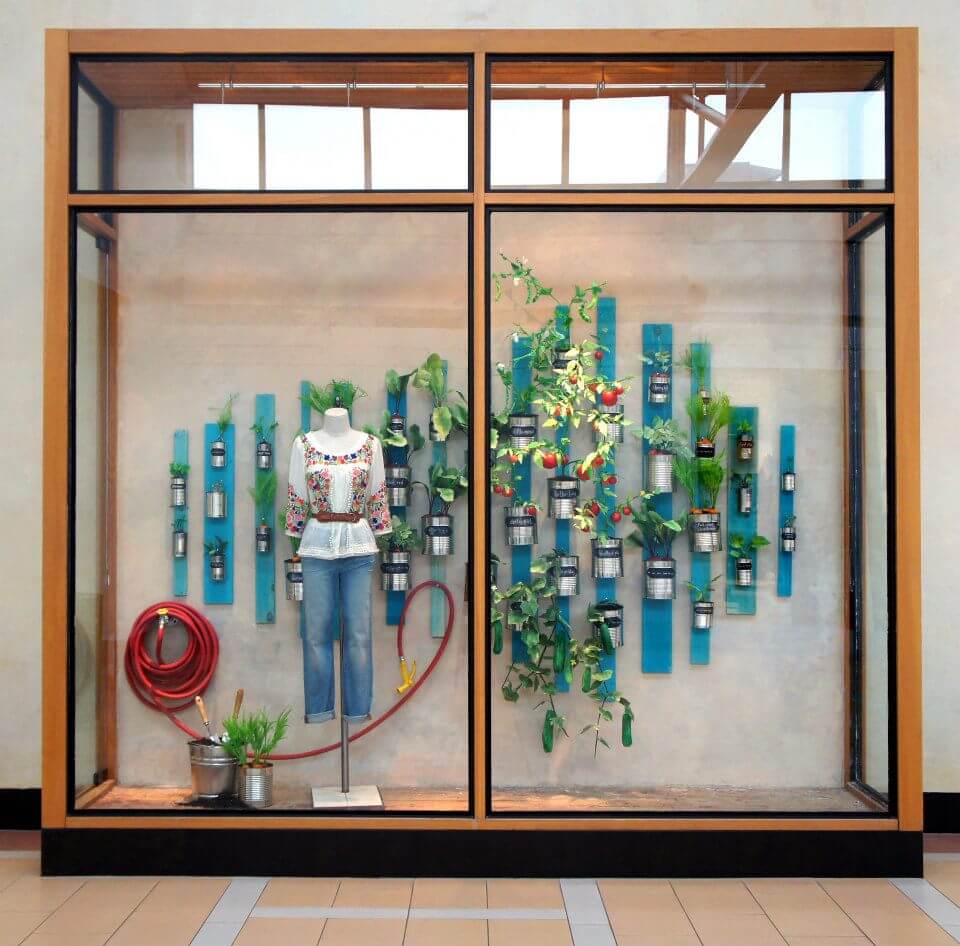
For instance, for Earth Day 2013, the retailer decided to “pay homage to the gifts of gardening with a variety of handcrafted fruits and veggies, and containers made from recycled cans, tires, bottles and more.”
Curb side displays
Curb side displays are similar to window displays in that they also aim to capture foot traffic as people walk past your store.
This is a great place to mention any specials or ongoing promotions that you have. These are typically relatively low cost to create, especially if you’ve got standard evergreen options or are using a chalkboard display that can be changed up regularly.
So don’t neglect your curb side. In addition to making sure store managers are keeping this space clean and tidy, consider having them add “curb side extras”. For example, why not set up a sandwich board outside shops with some eye-grabbing text or art? Doing so can make passers-by stop and pay attention.
Check out this great example from Covet Shoppe & Jewellery Bar in San Francisco.
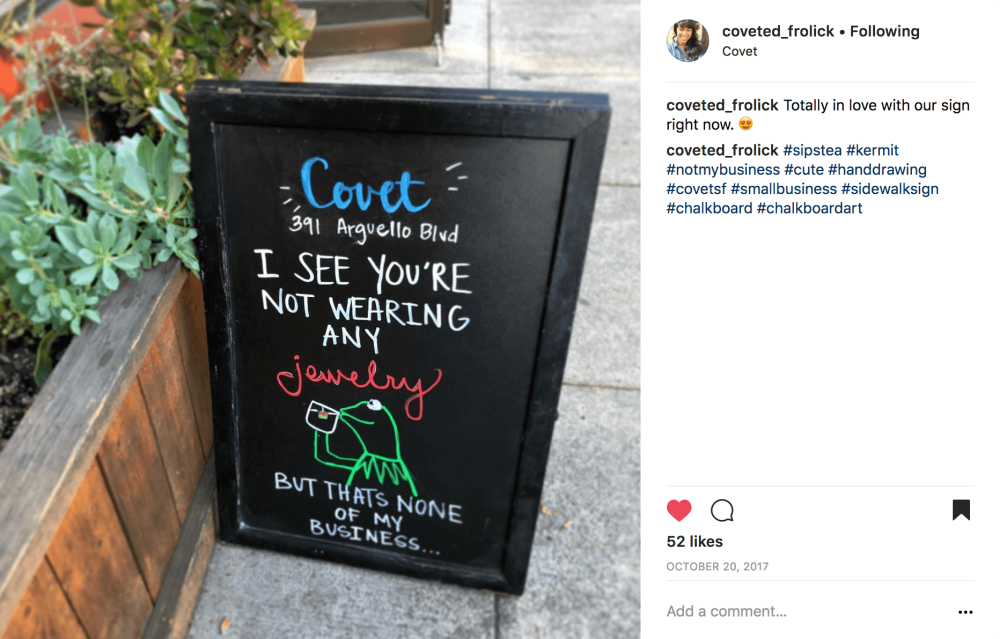
Staff
Your staff should all be trained in advanced sales techniques and know your inventory well. If they do, they’ll be able to do the selling for you, guiding customers to products that they’re looking for and even pointing out a few that they weren’t.
Well-trained staff, especially if they have access to an advanced commerce platform that clearly displays information about customers, will be able to identify potential add-on purchases, leveraging cross-selling and upselling to boost the overall purchase value. They’ll be excited about your brand and your products, so your customers will be, too.
Partnerships and collaborations
Establishing partnerships with other businesses is an excellent way to expand your reach
and connect with new audience members.
One popular way to land a partnership is to pitch your products to be sold at complementary businesses. For example, if you own a pet store and produce your own line of dog shampoo, you might be able to partner with a local veterinary office to see if they would stock your products.
Establishing partnerships with other local businesses is an excellent way to expand your reach
and connect with new audience members.
Here are some more ideas:
- Partner with the stores in the same location as you – If you’re in a strip mall or downtown area, you can ask the stores around you to offer your coupons to their customers (in return for you doing the same). The upside here is that you’ll be directly reaching people who are perfectly positioned to just pop by. The downside is that your neighbours’ clientele may not be your clientele.
- Partner with stores in the general area whose clientele are your clientele – If you have stores in the nearby area that service the same clientele as you, you can also ask them to offer your coupons. Alternatively, if you worry that no one will be motivated to drive to you based on coupons, you can always take your business to your partner and set up a pop-up shop for a day.
- Partner with a local charity to put on an event – Customers these days are much more socially conscious and like to shop with brands who care. Partnering with a local charity offers you the chance to hit two birds with one stone: get your name out to a new set of people and show your customers you care about making a difference at the same time. Choose a charity whose values align with your own and set up an event.
5. Consider SMS marketing
SMS marketing has been making waves, and for good reason: people love their phones. Research shows that US consumers check their phones 52 times a day and that text messages have a higher open rate (98%) compared to email (25%).
That’s why if you haven’t dipped your toes into SMS retail marketing, it may be time to do so. Start collecting your customers’ mobile numbers and send—with their permission—relevant marketing communications. Your marketing team can save time and make these communications more targeted by integrating your SMS platform with your POS to automate SMS campaigns.
One retailer that’s seen amazing results with SMS marketing is Federation +, a popular streetwear brand in New Zealand.
Federation + markets its brand on multiple channels, including SMS. One notable initiative is the brand’s end of the year SMS campaign, in which customers were offered a 20% discount both in-store and online. To give people a sense of urgency, the offer ended at midnight that same day.
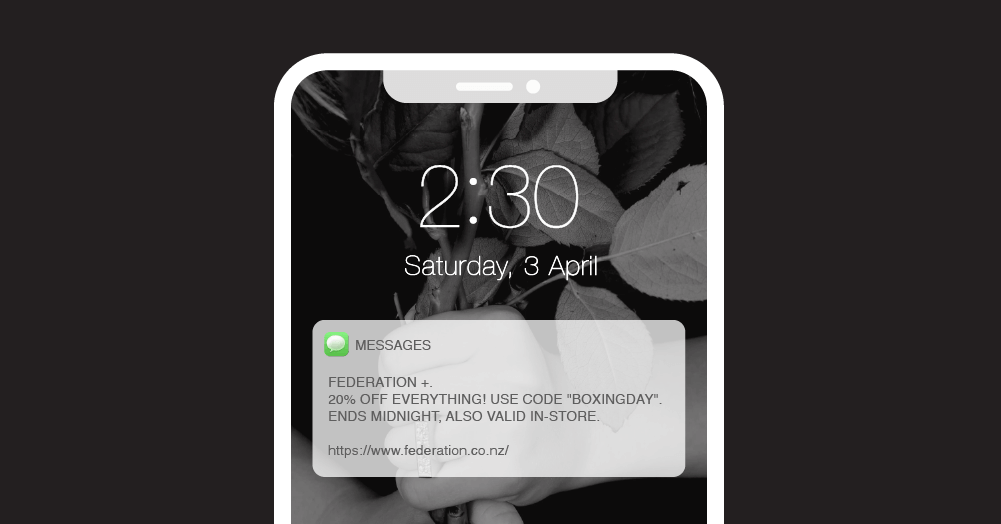
The initiative worked incredibly well. The campaign had a 95% delivery rate, an 8% click rate, and a conversion rate of 11%. Suffice it to say, Federation + ended the year strong!
6. Leverage video
In many cases, the best way to market your merchandise is to show your products in action. This is easily doable in-store, where shoppers can touch and feel products or even try them on. However, when marketing online, you need to get more creative with your visuals.
Enter video marketing. When leveraged correctly, video does an excellent job of showcasing the use cases and value proposition of your merchandise.
Here are some quick tips for directing your team to use video in your marketing:
Make them relatable. You want viewers to connect with your brand when they watch your videos. You can do this by making the content as relatable as possible. Start by featuring people who look like your target customers. If you’re targeting middle-aged moms, for example, then you’ll want to feature that persona in your content.
Choose the right format and platforms. Determine the best platform for your videos. Is your target audience on YouTube? Do they prefer TikTok or Instagram? The answers to these questions will help inform your video strategy. Factors like the length of your videos, the content you’ll produce, as well as the themes and effects that you’ll incorporate into the content, hinge on the platform on which your videos will live.
To make the video creation process easier, consider using a free online video maker tool. These tools allow you to create professional-looking videos without needing expensive equipment or specialised skills. With an online video maker, you can choose from various templates, add your branding, and customise your videos with text, images, and music.
Have a clear CTA. Determine what you want viewers to do after watching your content. Do you want them to follow you online? Check out a specific product page? Get in touch with you? Mention the CTA in your video or add a link in the description. In some cases, you can embed a CTA link into the content and ask viewers to “click” or “swipe up.”
One brand that’s doing a top-notch job with video marketing is Rebecca Minkoff. Rebecca often posts Reels on her Instagram page to showcase different apparel pieces and accessories. Rebecca Minkoff herself embodies that trendy female persona of her brand, so she’s the perfect subject to star in these videos.
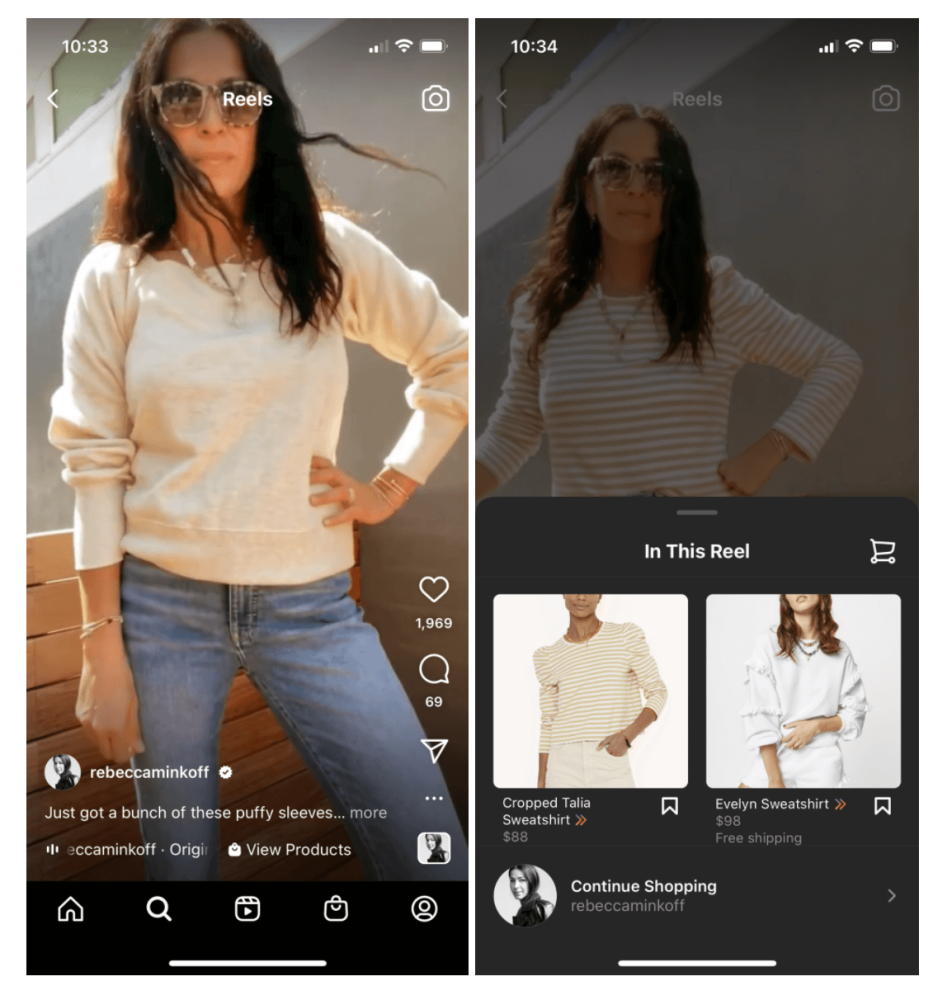 There’s also a clear CTA on most of her Reels. Whenever a product is featured in a video, Rebecca Minkoff tags those products so customers can easily view and purchase them.
There’s also a clear CTA on most of her Reels. Whenever a product is featured in a video, Rebecca Minkoff tags those products so customers can easily view and purchase them.
7. Try out direct mail
Here’s a form of retail advertising you might not have thought about in a while: direct mail. With digital advertising taking over marketing playbooks, many businesses underestimate the power of direct mail.
Direct mail has a higher ROI than many types of traditional and digital advertising, below just social media and email.
How you manage a direct mail campaign is up to you—you could try a national campaign focused more on your ecommerce presence, or hyper-local advertising campaigns for potential customers near your physical locations. Your marketing team should have data that will inform which tactic to take; if not, time for a test.
8. Online listings
Online listings are business directories that prospective customers can use to find and compare service providers. A business’ listing will often include your business name, address, phone number, and details on the service you provide. There are hundreds, if not thousands of directories you can create a listing on.
A Google My Business profile is a listing to prioritise, especially if you operate multiple locations. This listing will appear on Google when a person searches for your business, providing essential details like your store location, opening hours and customer reviews. Potential customers who are evaluating if they want to learn more about your business will most likely skim these details to qualify if your business is right for their needs.
Other online listings are used by potential customers who are researching and comparing businesses. You can make a note of which online listings your competitors and contemporaries have a presence and make a profile on those listings as well.
Podcast advertising
According to a 2023 report from ARN’s iHeart and Magellan AI, Australian podcast advertising has grown by 36% year on year. In particular, podcast genres TV & Film, Education and True Crime all saw increases in investment, up 110%, 100% and 87% respectively.
Data from Spotify also reveals that 1 in 3 internet users in Australia reported listening to podcasts last year, and over half of Gen Z respondents claimed the same.
Another data set from Spotify reveals that 57% of podcast listeners on Spotify say they’ll consume an entire episode from start-to-finish. 54% of podcast fans claim they’re more likely to consider buying from a brand they hear advertised on podcasts. 81% of listeners have taken an action after hearing a podcast ad, ranging from looking up a product online, to connecting with a brand on social media, to talking about a product with someone.
So with the podcast market in Australia ripe with potential new customers, there’s a few things you need to consider before undertaking podcast advertising.
- Do your audience research: Are they true crime fanatics? Or are they film buffs? When you understand your audience’s interests you’ll have a good idea of what podcast types to place your ads on.
- Decide what message to use: You don’t have all the time in the world for a long-winded pitch. With 15 to 30 seconds to pique a listener’s interest, you need to make sure your message is concise, enticing and has a clear call to action.
- Choose your creative: Will you hire a professional voice over artist, or will you opt to have the podcast hosts read your message in their own style?
- Measure your performance: Most podcast advertising platforms will feed performance reports back to you. It is crucial to analyse these reports and adjust your advertising strategy accordingly.
9 retail marketing and promotion ideas
How do you make your store an exciting place to be? How do you build brand affinity? Here are some retail marketing ideas you can consider.
1. Promote your loyalty program
Loyalty programs are a great promotional idea for retail stores to show their appreciation of repeat customers. Pulling purchase history and customer data from your commerce platform can help you craft more personalised promotions. 72% of customers say they will only engage with personalised messaging.
You can also consider adopting different platforms for your loyalty communications, including email, social media, and SMS text messaging. Giving customers choices on how they can be contacted also shows you’re paying attention to their preferences.
Segmenting loyalty program members based on sales history—you can do this automatically with Lightspeed Advanced Marketing—will help you ensure your campaigns are as tailored as possible, keeping customers engaged once they’ve signed up.
2. Start a referral campaign
Capitalise on word-of-mouth marketing with a referral campaign. While there are many variations on referral campaigns, the core idea is that you provide some sort of incentive for your happy customers to share the word about you to their friends.
Stitch Fix, a fashion box company, has referral marketing down to an art. Their referral campaign is such a permanent part of their strategy that it actually has its own page on their website.
Each customer is provided with a unique link to Stitch Fix’s home page. The customers can then share this link with their friends and social network. When someone purchases a box using that link, the original customer is given a $25 credit towards their next box. (And the new customer is enticed to make a purchase with their own $25 credit.)
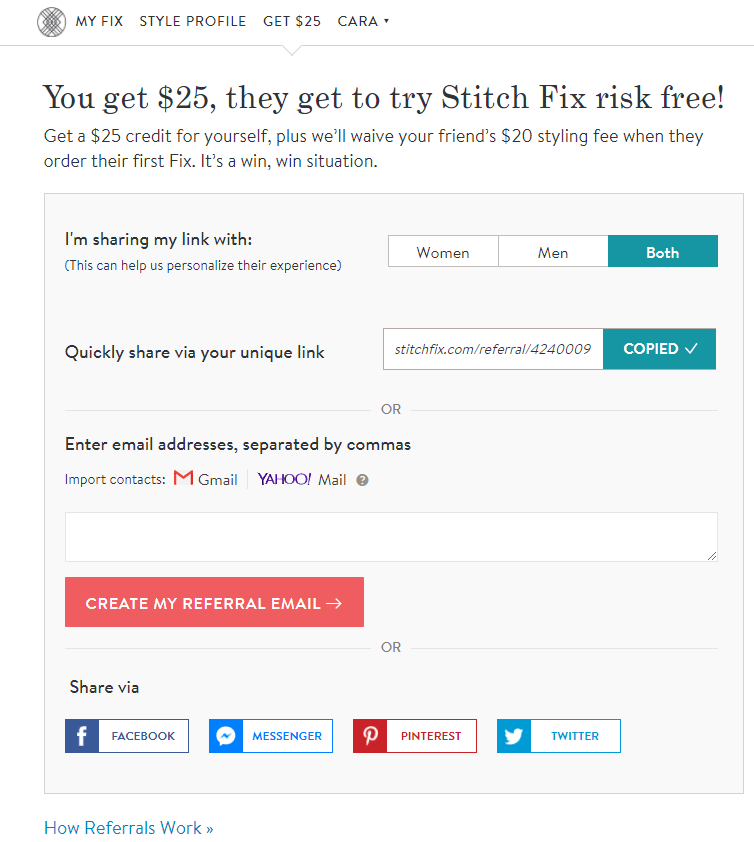
For stores looking to replicate Stitch Fix’s success, consider testing out referral marketing with an initial campaign. Choose your incentive, set up goals and get cracking.
Referral programs are an incredibly effective retail marketing strategy, with 92% of customers trusting recommendations from people they know.
Creating incentives for customers to refer their friends can bring in high-value traffic and encourage repeat purchases from both. A popular way to do this is to offer a coupon for customers and their friends if they successfully refer someone. You can promote your referral and loyalty programs both online and in-store.
3. Run a win-back marketing campaign
Marketing to new shoppers is great, but what about your existing customers? Specifically, those who haven’t shopped with you in a while. Identify inactive shoppers and win them back with a marketing campaign showing them what they’re missing.
A good example of this in action comes from Our Bralette Club (OBC), a lingerie retailer based out of Singapore. OBC uses their marketing platform to automatically run “win-back” campaigns.
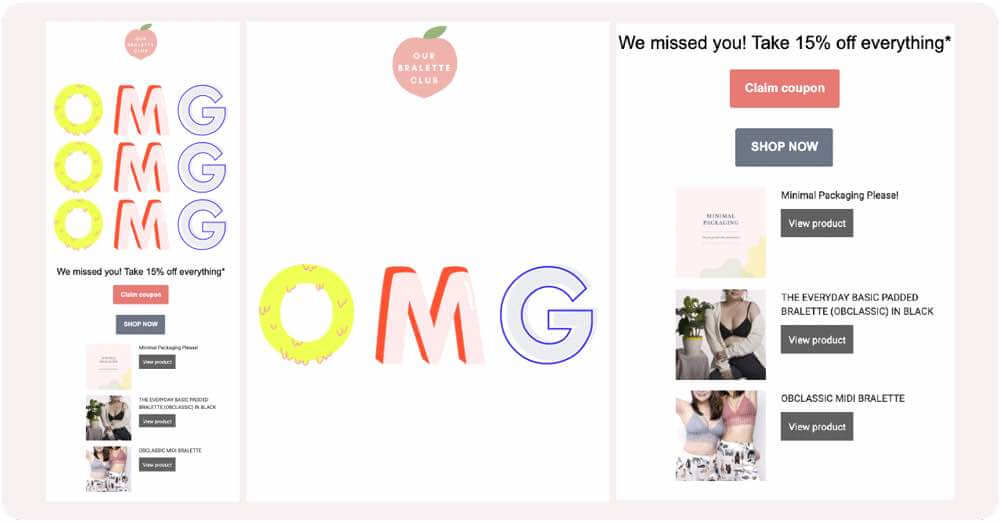
OBC automatically identifies customers who haven’t shopped with the brand in a while, and sends them a series of messages encouraging them to come back—complete with a 15% coupon. These messages have generated amazing results. OBC earned $4,000+ in revenue in just 4 months thanks to this automated email flow.
4. Run in-store events
In-store events can do wonders when it comes to bringing more foot traffic into locations. There are plenty of in-store event ideas that you can take advantage of. A wine store could hold a tasting, a studio gym could have a healthy cooking class and an art store could host a painting class, to name a few examples.
In addition to bringing traffic in and resulting in sales, events are also a great way to generate buzz on social media and nurture relationships with attendees.
You can connect your brand to both your community and a cause by hosting a charitable event that includes a donation. This is a powerful way to give back, while also reinforcing a positive reputation for your store. Showing that you care about doing good can impact how customers see you and your business.
5. Offer free wifi
Free wifi is becoming much more standard than in the past, but potential customers are still likely to see it as a perk—50% of customers are more comfortable making larger purchases in stores that offer free wifi.
And that’s a pretty good reason to offer free wifi in and of itself. But there’s a second benefit: free wifi is good marketing for retailers, because you can collect contact information to use in future campaigns and promotions.
6. Word of mouth
Word of mouth is an extremely potent method to build strong clout for your business. However, it’s just as easy to garner a bad reputation via word of mouth too.
There are 6 key factors to take into consideration if you want to leverage word of mouth proactively:
- Understand that your brand goes beyond your logo, it’s your values in action
- Customer happiness is influenced by employee happiness, you can’t have one without the other
- Trolls are out there, but don’t let them get to you
- Some customers can be difficult, but it’s better to keep the peace than start a war
- Nurture recurring customer’s loyalty and ask them to leave positive reviews
- Use feedback from unhappy customers to evaluate if there are any urgent issues with your service that can be improved
7. Google Shopping campaigns
Google Shopping campaigns are used to maximise product visibility, increase conversions, and drive revenue. These campaigns allow you to target specifically selected audiences who you want to reach.
This is particularly useful for retailers who run an eCommerce website, as shopping campaigns can drive new traffic to your site and retarget prospects who previously visited your site.
There are several strategies you can use:
- High-Quality Product Feed: Ensure your product feed is accurate, up-to-date, and optimised. Include essential product attributes such as titles, descriptions, images, prices, and availability.
- Detailed Product Information: Provide comprehensive and accurate product information to help potential customers make informed decisions. Include relevant details like brand, colour, size, material, and any unique selling points.
- Strategic Product Segmentation: Group your products into tightly themed product groups to optimise bidding and campaign management. This allows you to set different bids and budgets based on performance and profitability. Consider segmenting by product category, brand, price range, or any other relevant attribute.
- Competitive Pricing: Stay competitive by regularly monitoring and adjusting your product prices. Ensure that your pricing aligns with or offers value compared to your competitors. Utilise pricing strategies such as discounts, promotions, and bundling to entice potential customers and stand out from the competition.
- Optimal Bidding Strategy: Choose the appropriate bidding strategy based on your campaign goals. For maximum visibility, consider using the “Maximise Clicks” strategy. To drive conversions, use “Target ROAS” or “Maximise Conversions” strategies. Monitor your performance regularly and adjust your bids based on data-driven insights.
- Local Inventory Ads (LIA): If you have physical stores, leverage Local Inventory Ads to showcase your in-store inventory to nearby shoppers. This feature allows you to display real-time product availability, store information, and local promotions. By connecting online and offline experiences, LIAs can drive foot traffic and boost sales.
- Negative Keywords: Utilise negative keywords to refine your targeting and exclude irrelevant search queries. This helps you focus your ad spend on relevant traffic and avoids wasting resources on clicks that are unlikely to convert. Regularly review your search terms report and add negative keywords accordingly.
- Remarketing: Implement remarketing campaigns to re-engage users who have previously interacted with your website or products. Show personalised ads to remind them of products they showed interest in or abandoned in their shopping carts. This can significantly increase conversion rates and drive repeat purchases.
- Performance Monitoring and Optimisation: Continuously monitor the performance of your campaigns using Google Analytics and Google Ads reporting tools. Analyse metrics such as impressions, clicks, click-through rates (CTRs), conversion rates, and return on ad spend (ROAS). Optimise your campaigns based on these insights to improve performance over time.
- Mobile Optimisation: Given the increasing use of mobile devices for online shopping, ensure your website and product pages are mobile-friendly. Optimise load times, simplify navigation, and make the checkout process seamless to provide a positive user experience for mobile shoppers.
Remember, Google Shopping campaigns require ongoing management and optimisation. Regularly test new strategies, experiment with different ad formats, and stay up-to-date with Google’s latest features and recommendations.
8. Ad image best practices
Compelling and visually appealing images can significantly impact the performance of your ads and capture the attention of your target audience. Here are some guidelines to follow:
- High-Quality and Relevant Images: Use high-resolution images that are clear, well-lit, and visually appealing. Ensure that the images accurately represent the product or service you are promoting. If possible, include multiple angles or variations of the product to provide a comprehensive view.
- Consistent Branding: Maintain a consistent visual identity across your ad images to reinforce your brand. Use your brand’s colours, fonts, and design elements to create a cohesive look. This consistency helps in building brand recognition and trust with your audience.
- Use Lifestyle or Contextual Imagery: Show your product in real-life scenarios or use contextual imagery that relates to your target audience. This approach allows viewers to envision themselves using or benefiting from your product, making it more enticing and relatable.
- Show Unique Selling Points: Highlight the unique features or benefits of your product through visuals. If there are specific aspects that differentiate your product from competitors, emphasise them in the image. For example, if your product is eco-friendly, show it being used in an environmentally conscious setting.
- Test Multiple Variations: A/B testing is crucial to determine which images perform best. Create different versions of your ad images and compare their performance metrics, such as click-through rates (CTRs) or conversion rates. Test variations in colour schemes, layouts, or product arrangements to optimise your visual content.
- Adhere to Google’s Image Policies: Ensure that your ad images comply with Google’s image policies. Avoid using images with excessive text overlays or misleading elements. Familiarise yourself with the specific guidelines provided by Google to avoid any potential issues with ad approval.
- Mobile-Friendly Design: Optimise your ad images for mobile devices since a significant portion of online users access content through smartphones and tablets. Ensure that your images are clear, legible, and appropriately scaled for smaller screens.
- Regularly Refresh and Update Images: To prevent ad fatigue and maintain user interest, periodically update your ad images. Refreshing your visuals can catch the attention of repeat viewers and prevent your ads from becoming stale or ignored.
9. Include product ratings
Consumers value transparency and rely on the opinions and experiences of others when making purchasing decisions. By including product ratings in marketing material and on eCommerce pages, you can provide potential customers with valuable insights into the quality and performance of your products.
Firstly, product ratings serve as social proof, reassuring prospective buyers that others have already purchased and found the product satisfactory. Shoppers appreciate the ability to evaluate a product’s suitability based on real user experiences, enabling them to make informed choices that align with their preferences and requirements. This reduces the likelihood of post-purchase dissatisfaction, returns, and negative reviews.
Additionally, product ratings enhance your credibility as a retailer. They demonstrate that you value customer feedback and are willing to showcase both positive and negative reviews. By openly presenting customer opinions, you can build trust and authenticity with your target audience, fostering long-term customer loyalty.
Lastly, featuring product ratings in marketing collateral and on eCommerce pages can positively impact search engine rankings. Reviews contribute to user-generated content, which search engines like Google recognise as valuable and relevant. Higher rankings can increase online visibility, attract more traffic, and ultimately drive sales.
Find the right marketing mix for your retail store
Starting out with the right retail strategies for your campaigns can make a huge difference. When you’re choosing a retail marketing strategy that makes sense for your brand, you’ll be able to invest your budget wisely into in-store and online promotions that work well for you.
Remember, too, that all businesses can benefit from a strong marketing mix. Having different touch points allows you to be more discoverable and accessible to your customers.
Need stronger tools to manage your marketing efforts? Watch a demo to see how Lightspeed can help you make smarter business decisions.

News you care about. Tips you can use.
Everything your business needs to grow, delivered straight to your inbox.


